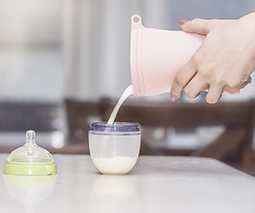Insufficient glandular tissue and true low milk supply: What you need to know

Although most woman can produce enough milk to feed their babies, for some, a condition called insufficient glandular tissue (IGT) can cause true low milk supply.
This is a rare physical condition that means there is not enough milk-making glandular tissue in the breast. While the size of your breasts has nothing to do with their milk-making potential, there are some physical markers that can indicate the presence of IGT. Breasts that are widely spaced apart (causing no cleavage), are different sizes, have stretch marks, are tubular in shape and do not change throughout pregnancy are all possible signs of breast hypoplasia – another term for IGT.
The first thing to know is that having any one of these signs does NOT necessarily mean you have IGT, although having several of them may suggest a higher risk of low milk supply. You should also know that many women with IGT go on to breastfeed their babies – some manage to produce a full milk supply while others manage to breastfeed in combination with other feeding methods.
Read more about low milk supply:
- 7 simple ways to increase your breast milk supply
- Does my breastfed baby need a formula top-up?
- Delayed arrival: When your breast milk comes in late
Signs of IGT
If you feel unsure about the size and shape of your breasts, seek out a consult with your GP, where you can explain your concerns. The physical characteristics associated with IGT include:
- widely spaced breasts (more than 3.5 centimetres apart)
- presence of stretch marks on the breasts, (without breast growth in puberty or pregnancy)
- tubular breast shape (a longer rather than fuller appearance)
- breast asymmetry (one breast is notably bigger than the other)
- disproportionately large or bulbous areolae
- the absence of usual breast changes during pregnancy and after childbirth
Many women with IGT may have always felt their breasts were different but it’s often when they notice no change in their breasts during pregnancy that they realise something isn’t quite right.
A prenatal breast assessment will help determine whether the physical characteristics you have indicate IGT, and if they do, a plan can be made to provide you with extra breastfeeding support.
Support with breastfeeding
Linking up with a breastfeeding counsellor or lactation consultant before your baby arrives can help you come up with a plan to work towards your breastfeeding goals in conjunction with your circumstances. Getting onto this early can help get you to get the best possible start when breastfeeding your baby, but also ensure have a backup plan ready as necessary. Forming a relationship with a health professional you trust will ensure you get consistent information and the support necessary to feed your baby.
Getting breastfeeding started
Your breastfeeding health professional will probably encourage you do everything you can initially to maximise your milk supply once baby arrives: putting baby to the breast often, avoiding feeding schedules, letting baby determine the end of the feed and using plenty of skin-to-skin opportunities early on, to promote a healthy breastfeeding relationship between you and your baby. Depending on how this goes, you may also be recommended to try a galactagogue, which can help your body produce milk.
Supplementing may be necessary
Working closely with a breastfeeding counsellor or lactation consultant can help you identify signs of healthy weight gain in your baby, and whether you need to supplement feed. If you’re not able to produce a full milk supply for your baby, you can do this with formula (bottles), donor milk, or use a breastfeeding supplementer, which uses a container and thin tube that delivers the supplement (breastmilk or formula) into baby’s mouth during breastfeeding. This technique helps baby get milk from the breast and the supplement, providing a satisfying and content experience at the breast for both of you.
Don’t lose heart
If you have IGT, try not to be discouraged. Your breastfeeding journey may not be as smooth as you hoped, but there’s still a good chance of being able to breastfeed your baby to some degree. Ensuring you have professional support as well as a good understanding of your feeding options will help you find the path that best works for you and baby.









